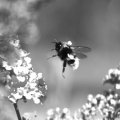A University of Queensland research team has been awarded patent protection for an innovative flat profile antenna which is cheap, robust, easy to mass manufacture, and matches the performance of large dish antennas.
Team members and co-inventors Associate Professor Marek Bialkowski and PhD student Paul Davis believe that the Flat Direct Broadcast Satellite (DBS) antenna is capable of replacing larger dish antennas like those currently in use for Galaxy TV, US, and European Pay TV.
'Unlike these conventional dishes, this antenna is less than 5 cm thick and we estimate it will have a manufacturing cost of less than $25,' Dr Bialkowski said.
'The Flat DBS Antenna is also multipurpose. Recently our research group has been investigating many other potential commercial mobile satellite applications such as fitting systems to commercial aircraft for live inflight pay TV systems, as well as investigating its usefulness in military applications.
'The new antenna can be formed completely into the skin of the aircraft without disturbing the original aircraft surface. This will ensure that the design imposes a zero drag penalty on the aircraft, requiring no extra fuel compensation.'
The antenna is only one of many prototypes being developed by the Wireless Communications Group in the University's Electrical and Computer Engineering Department. The group includes four senior academics, 13 PhD and seven masters candidates and a laboratory manager.
Its special area of expertise is mobile satellite antennas. However, researchers are shifting this substantial knowledge base into the current growth area of personal wireless communications.
Dr Bialkowski said the group was among the most productive in this field in Australia and had an excellent international reputation.
'Over the past five years the research group has produced many breakthroughs in wireless and satellite communications. They include an innovative briefcase satellite phone, an omni-directional mobile electronic tracking satellite antenna, and high efficiency array antenna systems,' he said.
'We have some of the best research and development facilities of any university in Australia for microwave and high frequency projects.
'These facilities will be further upgraded to take on substantial new research in areas as diverse as digital mobile phones, global low earth orbital satellites for receiving mobile phone communications, passive microwave security cards, intelligent highway systems, and the development of 3D temperature monitoring within a human body. '
Dr Bialkowski said the microwave research activities in the University's Electrical and Computer Engineering Department had spawned new commercial and employment opportunities in Queensland.
In the late 1980s Queensland microwave technology company MITEC was formed out of the group and has become an internationally recognised leader in the field of microwave communications systems.
'In addition, a considerable number of our graduates have found work with Australian companies at the leading edge of wireless communications technologies,' Dr Bialkowski said.
For further information, contact Dr Bialkowski, (telephone 3365 3563, email meb@elec.uq.edu.au) or laboratory manager Ray Whitehead (telephone 3365 3569, email rjw@elec.uq.edu.au).



